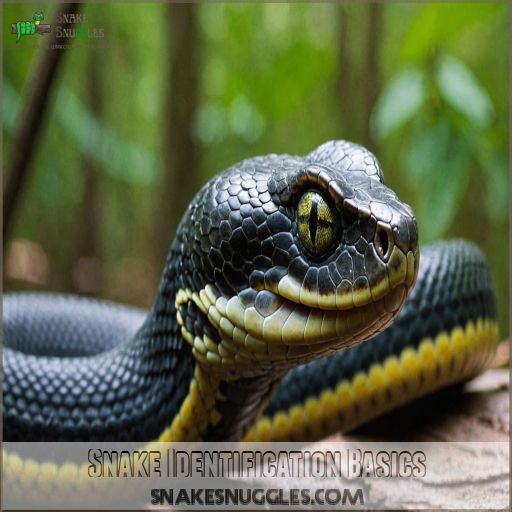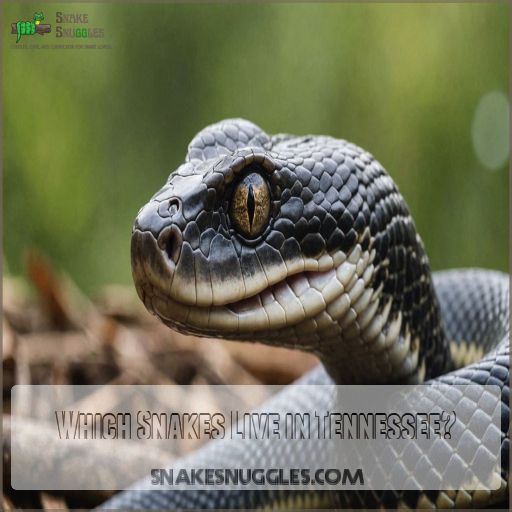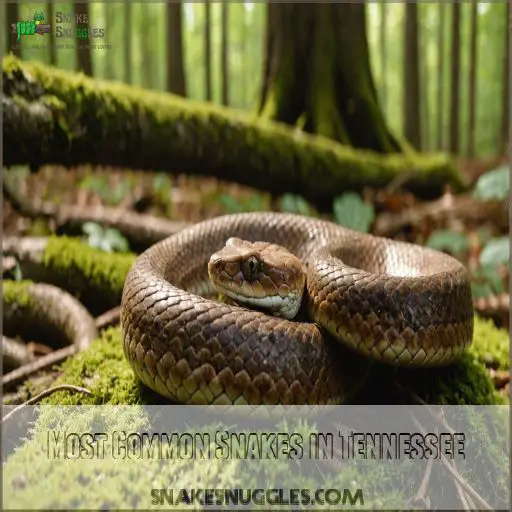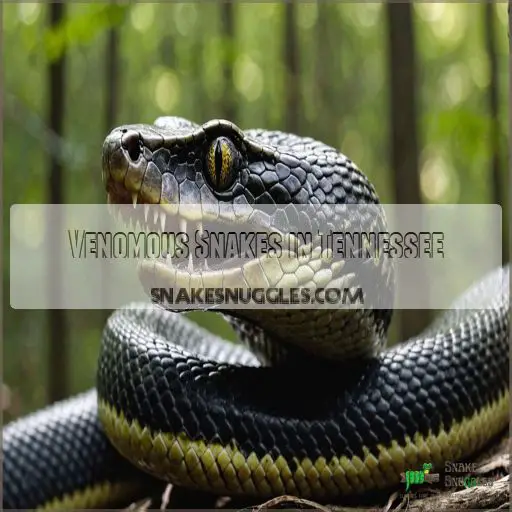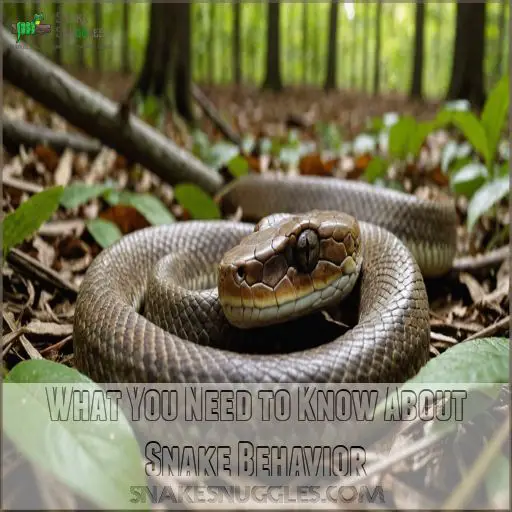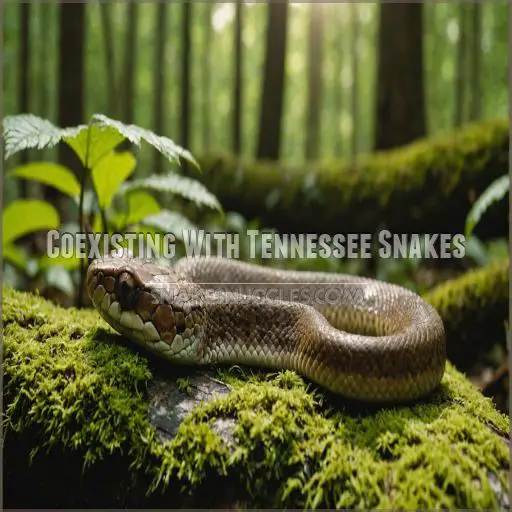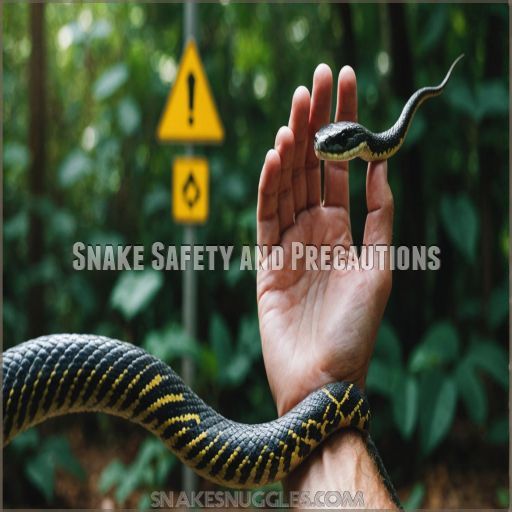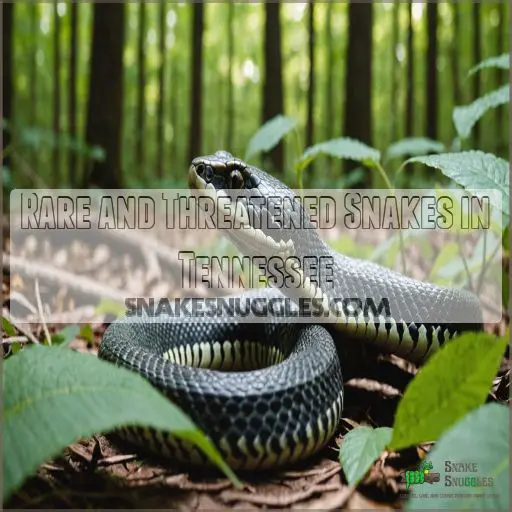This site is supported by our readers. We may earn a commission, at no cost to you, if you purchase through links.
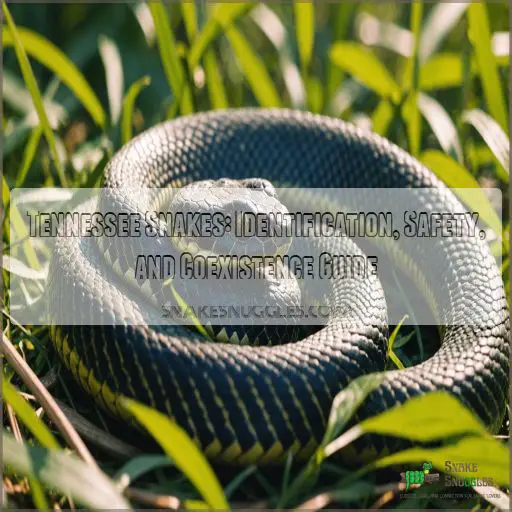 Spotting Tennessee snakes can feel like flipping through a wildlife magazine—it’s packed with drama and diversity.
Spotting Tennessee snakes can feel like flipping through a wildlife magazine—it’s packed with drama and diversity.
You’ll meet harmless garter snakes enjoying garden life or, if you’re less lucky, venomous pit vipers like the copperhead with its slit-eyed gaze lurking in forest shadows.
The key to identifying Tennessee snakes? Pay attention to their color, size, and those telltale triangular heads of venomous types.
Even our scariest serpents have a role in the ecosystem, so practicing safe distance viewings is best.
Ready to uncoil more fun facts and safety tips about these fascinating reptiles, and learn about the severity of a copperhead bite learn more about copperhead bites?? Slither on to discover what’s next!
Table Of Contents
- Key Takeaways
- Snake Identification Basics
- Which Snakes Live in Tennessee?
- Most Common Snakes in Tennessee
- Venomous Snakes in Tennessee
- Non-Venomous Snakes in Tennessee
- What You Need to Know About Snake Behavior
- Coexisting With Tennessee Snakes
- Snake Safety and Precautions
- Rare and Threatened Snakes in Tennessee
- Frequently Asked Questions (FAQs)
- What is the most common snake in Tennessee?
- Does Tennessee have venomous snakes?
- What is the largest snake in Tennessee?
- Does TN have cottonmouth snakes?
- How can I safely remove a snake from my property?
- What should I do if I encounter a venomous snake?
- How can I protect my pets from snake encounters?
- Are there any snakes that are illegal to own in Tennessee?
- How can I report a snake sighting to authorities?
- Conclusion
Key Takeaways
- Familiarize yourself with the distinct features of venomous snakes in Tennessee, like the Timber Rattlesnake’s rattle, the Copperhead’s hourglass pattern, and the Cottonmouth’s wide head – this knowledge can keep you safe while exploring the great outdoors.
- Appreciate the diverse roles non-venomous snakes play in Tennessee’s ecosystems, from the comedic Hognose snake to the graceful Rough Green Snake – these harmless creatures are fascinating to observe from a respectful distance.
- Practice snake-smart precautions when enjoying Tennessee’s natural wonders, like wearing sturdy boots, sticking to trails, and keeping pets leashed – this helps you coexist peacefully with our slithery neighbors.
- If you’re ever unfortunate enough to get bitten by a venomous snake, stay calm, immobilize the limb, and seek immediate medical attention – your safety is the top priority, so don’t hesitate to call for help.
Snake Identification Basics
In Tennessee, identifying snakes means being ready to spot key features like pupil and head shape, length, and patterns that distinguish the benign from the downright dangerous.
Think of it as a detective game where you carefully note the snake’s habitat and coloration while maintaining a safe distance—it’s all in the details, and there’s no need to rush into the "I found a snake" emergency dance!
Quickly Identifying a Venomous Snake
So you’ve stumbled upon a snake in Tennessee and you’re wondering if it’s venomous?
First, check the pupil shape – slit eyes, like cat eyes, likely belong to a pit viper.
Got a broad, flat head? Watch out! That might be a venomous contender.
Remember, snake habitats vary, so observe carefully before you panic.
Understanding Key Features for Identification
When identifying snakes, pay attention to features like snake scales, pupil shape, and head shape.
Pit vipers sport slit-shaped pupils and broad heads, like a well-worn cowboy hat.
Watch for intriguing body patterns, such as those on a ring-necked snake or a friendly ribbon snake.
Remember, a red-bellied snake’s dance is for the shallow stage, not the grand ballroom!
Using Length, Habitat, and Coloration for Identification
When identifying snakes in Tennessee, look for clues like length, habitat, and coloration.
Longer snakes may be rat snakes or water snakes, while smaller ones could be garter snakes or ring-necked snakes.
Snakes with distinct patterns like hourglass bands may be venomous copperheads.
Pay attention to where you spot them – aquatic habitats likely mean water snakes.
Which Snakes Live in Tennessee?
You’d be amazed at the variety of snakes crawling around Tennessee, from harmless garter snakes to rather intimidating rattlesnakes.
Understanding their habitats and behaviors is key to both admiring and safely avoiding these fascinating reptiles while exploring the Volunteer State.
Overview of Snake Species in Tennessee
Who would’ve thought Tennessee is home to such diverse snake life? You’ve got everything from the worm snake to the majestic common kingsnake, along with species like the milk snake and northern pine snake.
Exploring Tennessee’s habitats, you might even spot the elusive crowned snake.
Understanding snake diversity and their habitats is key, bringing knowledge, safety, and appreciation for these incredible creatures.
Listing of Common and Venomous Snakes
In Tennessee, snakes weave a fascinating tale of diversity. Here’s a bite-sized glimpse at some you’ll encounter:
- Venomous pit vipers: Including the Cottonmouth and Copperhead; handle them like a hot potato.
- Garter snakes: Frequent visitors, they appreciate garden parties.
- Hognose snakes: Drama queens in disguise—Oscar-worthy performances.
- Scarlet snakes: Bold patterns, no sting.
- Green Watersnakes: Nature’s water ballet.
Geographic Distribution of Snakes in Tennessee
Tennessee’s diverse snake populations thrive in the state’s varied landscapes.
From the rugged mountains to the lush wetlands, each region hosts its own unique snake species.
While some snakes, like the adaptable gray ratsnake, roam far and wide, others, such as the threatened plain-bellied watersnake, are found only in specific habitats.
Understanding where different snakes live is key to coexisting safely.
Most Common Snakes in Tennessee
You might be surprised by the variety of snakes in Tennessee, from the agile garter snake to the secretive ring-necked snake.
Discovering these snakes can feel like a backyard safari, but remember, they’re more interested in rodent snacks than in meeting you.
Rat Snakes and Corn Snakes Pantherophis
Switching gears from the general snake overview, let’s take a closer look at rat snakes and corn snakes, both falling under the Pantherophis genus. They’re nonvenomous and play a big role in pest control. Interested in these slithery friends?
- Habitat: Often found in forests and farmlands.
- Behavior: Docile and non-aggressive.
- Diet: Primarily rodents.
Water Snakes in Tennessee Nerodia
Water snakes, especially of the Nerodia species, splash about in Tennessee’s aquatic playgrounds.
Who would’ve thought wearing a brown and orange blotched outfit would be trendy?
They love relaxing on branches overhanging the water, but watch out!
Their bite’s a harmless bluff.
Knowing their habitat can keep your toes dry.
Feeling adventurous?
| Trait | Description | Humor Tidbit |
|---|---|---|
| Habitat | Swamps and lakes | Enjoys spa days! |
| Size | 24-48 inches | Long enough to impress…a fish |
| Activity | Dawn and dusk | Night owls in water! |
| Diet | Small fish and frogs | Gourmet in the pond! |
Garter Snakes Thamnophis
Garter snakes are a common sight in Tennessee, known for their thin, slender bodies and distinctive striped patterns.
These adaptable reptiles thrive in a variety of habitats, from gardens to wetlands, where they hunt small prey like insects, amphibians, and rodents.
Garter snakes are generally harmless to humans, but it’s best to observe them from a safe distance and avoid handling them.
Kingsnakes Lampropeltis
Although kingsnakes might not wear crowns, they’re royalty in the snake world for a reason. Here’s how they rule their domain in Tennessee:
- Diet: Immune to other snake venoms, they feast on poisonous prey.
- Behavior: Kingsnakes are as calm as a summer breeze.
- Habitat: They’re versatile, thriving in many environments, highlighting their adaptability.
Ring-necked Snakes Diadophis Punctatus
Ring-necked snakes, like kingsnakes, are fascinating creatures.
They’re beneficial garden allies, with diets primarily of insects and earthworms.
Found in hardwood forests, they curl defensively and release a foul odor when threatened.
Here’s a quick glance:
| Trait | Description | Fun Fact |
|---|---|---|
| Size | Up to 14 inches | They’re the Houdinis of escape artists! |
| Color | Black or brown | With a festive hidden belly! |
| Activity | Nocturnal | All-night earthworm snack party! |
| Conservation | Stable | Let’s keep their party venues intact! |
Venomous Snakes in Tennessee
Venomous snakes in Tennessee might not be your ideal house guests, but knowing how to identify them can keep things friendly between you and these slithering locals.
From the intimidating Timber Rattlesnake to the easily overlooked Pygmy Rattlesnake, it’s like a reptile family reunion where everyone’s got a distinctive scale pattern and a not-so-friendly bite, best viewed from afar.
Timber Rattlesnakes
The Timber Rattlesnake is the largest venomous snake in Tennessee, growing up to 60 inches long.
These pit vipers have a distinctive brown or gray coloration with dark brown or black bands.
While not typically aggressive, they’ll defend themselves if threatened, delivering a potent hemotoxic venom that can cause serious harm.
Respect their space, and you’ll both stay safe.
Pygmy Rattlesnakes
After learning about Timber Rattlesnakes, let’s chat about their mini-cousins, Pygmy Rattlesnakes! They may be small, but their venom packs a punch.
These petite rattlers:
- Thrive in forests and wetlands.
- Snack on frogs, insects, and lizards.
- Use camouflage for their protection.
- Play important roles in maintaining the balance of nature.
Approach with caution and curiosity, not fear!
Eastern Copperhead Agkistrodon Contortrix
Let’s now talk about Eastern Copperheads. These sneaky snakes sport a tan body with dark hourglass bands—nature’s camouflage at its best!
Found lounging in forests and rocky areas, they’re not aggressive unless provoked. Their bites are painful though rarely fatal.
| Feature | Details |
|---|---|
| Length | 24-40 inches |
| Habitat | Forests, rocky hillsides |
| Diet | Rodents, insects |
| Venom | Hemotoxic |
| Behavior | Shy, bites when threatened |
Northern Cottonmouth Agkistrodon Piscivorus
Unlike the Eastern Copperhead’s hourglass charms, Northern Cottonmouths mean business.
Found in watery chaos across western Tennessee, these semi-aquatic serpents reveal their threatening "cottonmouth" when annoyed.
Their broad triangular head signals a scrappy fellow ready for action.
Feeding on fishy and feathery feasts, they’re best admired from afar—because a Cottonmouth bite guarantees an express ticket to the nearest doctor!
Comparison of Venomous Snakes in Tennessee
Tennessee’s venomous snakes have distinct features – the Timber Rattlesnake’s telltale rattle, the Pygmy Rattlesnake’s tiny size, the Copperhead’s hourglass pattern, and the Cottonmouth’s wide, triangular head.
While each poses unique risks, their venom can cause serious harm.
Knowing how to identify them is important for staying safe in snake country.
Non-Venomous Snakes in Tennessee
You’ll find an array of non-venomous snakes slithering through the Volunteer State, each with its own unique charm and purpose.
From the crafty hognose snake playing dead to avoid trouble, to the elegant green snake gracefully blending into the trees, these harmless creatures are fascinating to observe.
These harmless creatures are important to the ecosystem.
Hognose Snakes
Hognose snakes are nature’s little comedians—masters of disguise.
You’ll find them play-acting in habitats like sandy soils and woodlands.
Their diet includes frogs and toads, but their real claim to fame is their dramatic mimicry.
- Feigned death performance
- Adorable upturned snout
- Not venomous—just misunderstood
- Makes you want to watch their antics
- Surprisingly friendly!
Queen Snake
Ah, the mighty Queen Snake! Similar to a drama queen, it’s all about appearances, primarily dwelling in aquatic environments.
| Feature | Detail |
|---|---|
| Habitat | Streams and ponds |
| Diet | Crayfish connoisseur |
| Behavior | Shy, not hostile |
| Conservation | Protected in some areas |
Keep an eye out for its sleek, gray body!
Dekays Brownsnake
One of the smallest snakes in Tennessee, the Dekay’s Brownsnake grows up to just 13 inches long.
These diminutive critters prefer to hide under leaf litter during the day, emerging at night to feast on soft-bodied prey like earthworms.
Despite their tiny size, Dekay’s Brownsnakes are:
- Secretive
- Harmless
- Excellent burrowers
- Sensitive to habitat loss
- Fascinating to observe
North American Racer
Dekays Brownsnake may be small and sneaky, but the North American Racer takes speed to a whole new level.
These slender, non-venomous creatures are sprinters of the snake world, chasing down small mammals and bird eggs.
Living in dryland locations, Racers dash into hiding when humans appear, only risking a bite if cornered. Their quick yet elusive nature keeps them thriving.
Rough Green Snake
Ever wondered about the vibrant green thread slithering through your garden?
It’s probably Tennessee’s own Rough Green Snake.
Known for their acrobatics in the trees and penchant for an insect diet, these gentle creatures avoid humans like the plague.
Delight in their glossy green scales and graceful movements—they’re a harmless companion to have in your backyard jungle.
What You Need to Know About Snake Behavior
You might think snakes are all about cryptic stares and stealthy movements, but they’re actually fascinating creatures with curious habits and unique communication styles.
By learning how they hunt, interact, and survive in various habitats, you’ll gain a deeper appreciation for their important role in Tennessee’s ecosystems.
Understanding Snake Habitat and Behavior
Snakes inhabit a wide range of habitats across Tennessee, from lush forests to arid grasslands.
Snakes are generally solitary and prefer to avoid confrontation, using camouflage and stealth to hunt small prey like rodents, birds, and insects.
Respect their space, and they’ll likely return the favor.
By understanding their behaviors, you can coexist peacefully.
Snake Communication and Body Language
Snakes communicate a lot through their body posture and tail movements!
Hissing cues, those snake signals, often mean, "Back off, buddy!"
A raised head or coiled body shows they’re on defense mode, while a rattling tail warns of looming danger.
Snakes have defensive tactics, and understanding these behaviors helps us peacefully coexist with our slithery friends.
Snake Diet and Hunting Habits
Understanding what Tennessee snakes munch on can be enlightening.
From eating tiny insects to ambushing larger prey, these reptiles have diverse dietary preferences.
Some employ stealthy ambush tactics, waiting patiently for the right moment.
While others actively pursue their meals.
This varied snake menu means you might spot a snake mid-hunt—don’t worry, you’re not on the menu!
Coexisting With Tennessee Snakes
Encountering a snake while exploring Tennessee’s diverse landscapes can be an exhilarating experience if you know what to do.
Remember, a snake’s preferred pastime isn’t chasing humans but silently contributing to the ecosystem, so respect their space and keep your toes where they belong!
Treading Carefully in Snake Habitat
While exploring Tennessee’s diverse landscapes, it’s important to tread carefully and stay alert for potential snake encounters.
Familiarize yourself with common snake habitats, such as rocky outcrops, tall grass, and wetlands, to navigate these areas safely.
Wear sturdy boots, stick to well-worn paths, and use a hiking cane to avoid accidentally stepping on camouflaged snakes.
If You Encounter a Snake
Spotting a snake can feel like discovering an uninvited guest at your garden party.
Stay calm, respect its space, and observe quietly.
Snake safety is about giving them freedom to slither away.
For snake identification, notice its size, color, and patterns.
Avoid prodding, it’s not a curiosity test!
Let snake behavior be your guide in deciding if removal is necessary.
When to Call for Help
If you find a snake causing a ruckus near your home, it’s time to call for help!
A professional can make sure everyone’s safety.
Here’s when you should definitely pick up the phone:
- Venomous snake sighting.
- Close proximity to children or pets.
- Snake trapped inside your home.
- Suspected snake bite from a venomous snake.
Let’s keep things under control!
Precautions for Outdoor Activities
When enjoying the great outdoors in Tennessee, it’s smart to anticipate the unexpected.
Always wear sturdy shoes and stick to marked trails—snakes don’t like surprises either!
Pack a snake bite prevention kit and brush up on first aid, just in case.
Flashlights at night, avoiding tall grass, and securing your campsite are keys to a fun, safe adventure.
Snake Safety and Precautions
With Tennessee’s diverse snake population, prevention and avoidance are key. If bitten, remain calm, apply first aid, and seek immediate medical attention – your safety is paramount.
Prevention and Avoidance
Imagine this: enjoying a serene hike, when suddenly, a slithery friend crosses your path.
Practice snake-safe hiking by wearing boots and sticking to trails.
For pet safety, keep pets leashed in known snake zones.
Yard precautions like trimming grass reduce snake hideouts.
Got a green thumb? Garden protection includes sealing holes.
Camping tips: shake out shoes in the morning.
What to Do if You Are Bitten
Snake bite symptoms might send you into a tizzy, but don’t panic—stay calm and take quick action after reviewing snake bite effects.
First, identify if the bite is from a venomous or non-venomous snake.
It’s essential for medical care.
Remember, prevention tips can help dodge future encounters.
Keep a keen eye on nature’s sneaky creatures, and you’ll enjoy freedom and safety outdoors!
First Aid for Snake Bites
Got bitten? Let’s handle it!
- Stay Calm: Panicking will only pump venom quicker, like speeding up on a bumpy road.
- Immobilize: Keep the bitten limb still and lower than your heart. Think of it as a pet snake that wants to nap.
- Avoid Remedies: No cutting or sucking the wound. These outdated tricks do more harm than good!
Seeking Medical Attention
If you are unfortunate enough to get bitten by a venomous snake, don’t panic – just get to the nearest hospital as quickly as possible.
Time is of the essence, so call 911 or have someone drive you right away.
The medical staff will assess the bite and provide the appropriate treatment, which may include antivenom and other life-saving measures.
| Symptom | Severity | Action |
|---|---|---|
| Swelling, pain, discoloration | Mild | Seek medical attention within 4-6 hours |
| Difficulty breathing, rapid pulse | Moderate | Seek immediate medical care |
| Severe bleeding, paralysis | Severe | Call 911 or get to the ER right away |
Rare and Threatened Snakes in Tennessee
In Tennessee, you’ll find some rare snakes like the Plain-bellied Watersnake, Coachwhip, and Milk Snake, which deserve our attention and respect.
Conservation efforts are important to protect these fascinating creatures and their habitats.
While they might not star in a reptilian superhero movie, these snakes deserve our attention and respect.
Plain-bellied Watersnake
Plain-bellied Watersnakes might seem like slippery characters, but they’re part of Tennessee’s hidden treasures.
This rare snake deserves a closer look, not just for its plain belly, but for its role in the ecosystem.
Protect their swampy habitats, and you’ll help them thrive.
Remember, keeping these watersnakes safe is key to ensuring their continued survival and ecosystem balance.
Coachwhip
Moving from the aquatic life of the Plain-bellied Watersnake, let’s explore the Coachwhip. This rare, long snake in Tennessee might remind you of a whip with its slender body.
Known for its "periscoping" hunting style, it’s a sleek predator in dry habitats.
Remember to appreciate these unique creatures; they’re part of precious conservation efforts protecting Tennessee’s wildlife tapestry.
Milk Snake
The Milk Snake, a rare and threatened species in Tennessee, is a sight to behold.
This striking snake boasts distinctive red, black, and white bands that resemble the venomous Coral Snake.
To identify it, look for:
- Smooth, glossy scales
- Elliptical pupils
- A calm, docile temperament
These non-venomous snakes play a key role in the ecosystem, controlling rodent populations.
With proper habitat conservation, we can help them thrive in the Volunteer State.
Conservation Efforts for Endangered Snakes
You’re out hiking and suddenly meet a rare snake—it’s like finding a needle in a haystack!
Conservation is really important due to habitat loss.
Wildlife corridors and public awareness play pivotal roles in snake protection.
Adequate funding is the backbone of these efforts.
| Conservation Effort | Role |
|---|---|
| Habitat Protection | Prevents loss |
| Wildlife Corridors | Connects habitats |
| Public Awareness | Educates public |
| Funding | Supports programs |
Let’s protect these fascinating creatures together!
Frequently Asked Questions (FAQs)
What is the most common snake in Tennessee?
In Tennessee, you’ll likely encounter the Gray Ratsnake slithering around.
Known for its persistence like a “snake in the grass,” it’s the most common, growing up to 72 inches while controlling pesky rodent populations.
Does Tennessee have venomous snakes?
Think of Tennessee’s nature as a vibrant painting, but watch out for the four venomous snakes that can add unexpected brushstrokes of danger: Timber Rattlesnakes, Pygmy Rattlesnakes, Eastern Copperheads, and Northern Cottonmouths.
Stay curious but cautious!
What is the largest snake in Tennessee?
The timber rattlesnake holds the crown as Tennessee’s largest snake, stretching up to 60 inches.
Imagine it slithering through the forest with the grace of a ballet dancer!
Safety first, though—it’s venomous, so keep your distance!
Does TN have cottonmouth snakes?
Yes, Tennessee is home to the venomous cottonmouth snake, also known as the water moccasin.
These heavy-bodied pit vipers can grow up to 42 inches long and are found in the western part of the state.
How can I safely remove a snake from my property?
Imagine encountering a curious corn snake in your backyard.
Leave it alone and call a local wildlife expert for help.
They’ll handle the slippery visitor safely, like calling in a skilled snake wrangler from an action movie.
What should I do if I encounter a venomous snake?
Spotting a venomous snake? Keep cool as a cucumber!
Back away slowly, giving it plenty of room.
Don’t play Indiana Jones. Snakes aren’t out for heroics; they just want their space.
Stay safe and let them be.
How can I protect my pets from snake encounters?
Imagine your furry friends scampering through the yard – a snake’s slithering presence could spell trouble.
Safeguard them with sturdy fencing, clear brush, and vigilance.
Your pets’ wellbeing is paramount; outsmart those sneaky serpents for their protection.
Are there any snakes that are illegal to own in Tennessee?
In Tennessee, it’s illegal to own venomous snakes as pets, including all venomous species such as rattlesnakes and copperheads, according to state regulations.
Only zoo facilities can keep them.
Keep non-venomous species for your scaly companionship instead (Source).
How can I report a snake sighting to authorities?
You can report a snake sighting in Tennessee to the tennessee wildlife resources agency by calling (615) 781-6500 or emailing [email protected].
Stay safe, don’t fret, and let the experts handle it! (Source).
Conclusion
With over 30 snake species slithering through Tennessee, identifying them becomes essential, especially since only 4 are venomous. Remembering that can ease your mind and help you appreciate these reptiles.
By understanding their behavior and habitat, you can safely coexist with Tennessee snakes without unwanted surprises.
Keep your curiosity sharp and your eyes peeled for these fascinating creatures. Whether you’re discovering a harmless garter snake or a stealthy copperhead, knowledge is your best defense!

